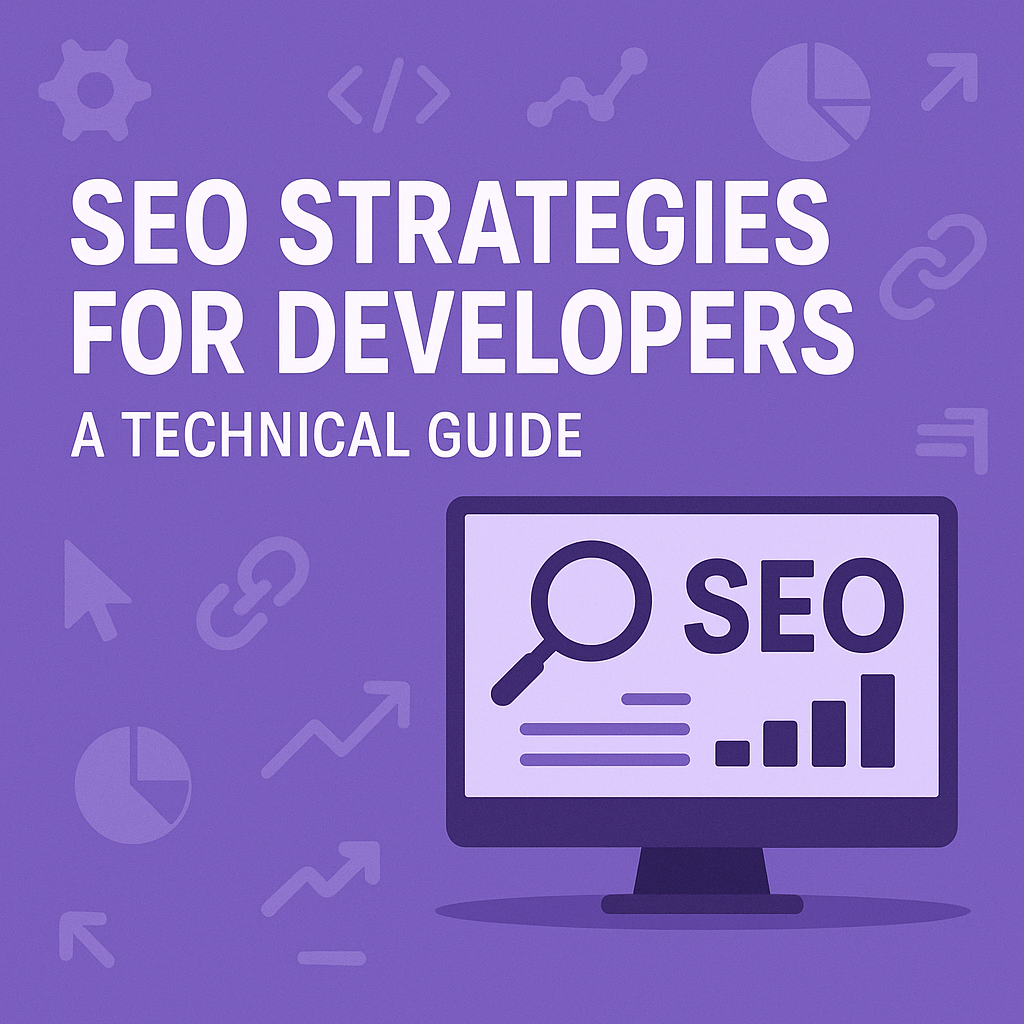SEO for Developers: Beyond the Basics
In 2025, technical SEO has evolved far beyond simple meta tags and keyword optimization. Today's search engines utilize sophisticated algorithms that evaluate technical implementation, user experience metrics, and semantic content relationships. As a developer, you're uniquely positioned to influence these critical ranking factors directly.
Key Technical SEO Factors in 2025
- Core Web Vitals (LCP, INP, CLS) account for 35% of ranking weight
- Structured data completeness impacts 60% of rich results
- JavaScript rendering optimization affects 75% of modern websites
- Page experience signals now include semantic HTML assessment
- Mobile-first indexing has expanded to include foldable device experience
This guide covers advanced technical SEO strategies specifically for developers, focusing on implementation techniques that deliver measurable ranking improvements.
Core Web Vitals Optimization
Core Web Vitals continue to be crucial ranking signals in 2025, with refined metrics that more accurately measure real user experience.
Largest Contentful Paint (LCP) Optimization
LCP measures loading performance. Aim for 2.5 seconds or faster:
- Implement preloading for critical resources with the
fetchpriority="high"attribute - Use server-side rendering (SSR) or static site generation (SSG) for critical content
- Optimize your critical rendering path by reducing render-blocking resources
- Implement efficient image loading strategies (next-gen formats, proper sizing, CDN)
- Consider partial hydration techniques for JavaScript frameworks
<!-- Preload critical resources -->
<link rel="preload" href="/fonts/main.woff2" as="font" type="font/woff2" crossorigin>
<link rel="preload" href="/images/hero.webp" as="image" fetchpriority="high">
<!-- Defer non-critical JavaScript -->
<script src="/js/analytics.js" defer></script>
<!-- Specify image dimensions to prevent layout shifts -->
<img src="/images/hero.webp" width="1200" height="600" alt="Description" fetchpriority="high">Interaction to Next Paint (INP) Optimization
INP has replaced First Input Delay (FID) as the primary interactivity metric. Aim for 200ms or better:
- Break long JavaScript tasks into smaller chunks (less than 50ms each)
- Use web workers for complex calculations and background processing
- Implement proper debouncing and throttling for event handlers
- Optimize JavaScript execution with requestAnimationFrame and requestIdleCallback
- Reduce main thread work with efficient DOM manipulation
// Use a web worker for intensive calculations
const worker = new Worker('/js/worker.js');
worker.onmessage = function(e) {
// Handle the result from the worker
updateUI(e.data);
};
// Send data to the worker instead of blocking the main thread
worker.postMessage({data: complexData});
// Implement efficient event handling
function debounce(func, wait) {
let timeout;
return function() {
clearTimeout(timeout);
timeout = setTimeout(() => func.apply(this, arguments), wait);
};
}
// Apply to event handlers
window.addEventListener('resize', debounce(recalculateLayout, 150));Cumulative Layout Shift (CLS) Optimization
CLS measures visual stability. Aim for 0.1 or less:
- Always specify width and height attributes for images, videos, and iframes
- Use CSS aspect-ratio or containment to reserve space for dynamic content
- Avoid inserting content above existing content
- Precompute sufficient space for embeds and ad slots
- Use CSS transform for animations instead of properties that trigger layout changes
/* Reserve space for dynamic content */
.banner-container {
aspect-ratio: 16 / 9;
width: 100%;
height: auto;
background-color: #f0f0f0;
}
/* Use transform for animations */
@keyframes move {
from { transform: translateX(0); }
to { transform: translateX(100px); }
}
/* Instead of */
@keyframes badMove {
from { left: 0; }
to { left: 100px; }
}Core Web Vitals Thresholds for 2025
| Metric | Good | Needs Improvement | Poor |
|---|---|---|---|
| LCP | ≤ 2.5s | 2.5s - 4.0s | > 4.0s |
| INP | ≤ 200ms | 200ms - 500ms | > 500ms |
| CLS | ≤ 0.1 | 0.1 - 0.25 | > 0.25 |
Advanced Structured Data Implementation
Structured data has become even more critical in 2025 as search engines increasingly rely on it for rich results, knowledge panels, and AI-driven features.
JSON-LD Implementation
JSON-LD remains the preferred structured data format:
<script type="application/ld+json">
{
"@context": "https://schema.org",
"@type": "Article",
"headline": "SEO Strategies for Developers",
"author": {
"@type": "Person",
"name": "Tony Karnauch"
},
"datePublished": "2025-06-06T16:00:00Z",
"dateModified": "2025-06-06T16:00:00Z",
"publisher": {
"@type": "Organization",
"name": "Tony Karnauch Web Design",
"logo": {
"@type": "ImageObject",
"url": "https://tonykarnauch.com/logo.png",
"width": 600,
"height": 60
}
},
"mainEntityOfPage": {
"@type": "WebPage",
"@id": "https://tonyweb.design/blog/seo-strategies-for-developers"
},
"image": "https://tonykarnauch.com/blog/seo-strategies-for-developers.jpg"
}
</script>Multiple schema types can be implemented together to provide comprehensive data:
- Implement
ArticleorBlogPostingfor content pages - Add
FAQschema for question/answer sections - Use
BreadcrumbListfor navigation hierarchies - Implement
ProductandReviewfor e-commerce - Add
OrganizationandWebSitefor entity recognition
Testing and Validation
Always validate your structured data:
- Use Google's Rich Results Test and Schema Markup Validator
- Test for completeness by including all recommended properties
- Ensure schema relationships are properly nested
- Verify schema matches visible page content
- Monitor rich result performance in Google Search Console
| Schema Type | Rich Result Type | Required Properties |
|---|---|---|
| Article | Rich article snippet | headline, author, datePublished, publisher |
| FAQPage | FAQ accordion | question, acceptedAnswer |
| HowTo | Step-by-step card | name, step (with text and optionally image) |
| BreadcrumbList | Breadcrumb trail | itemListElement (with name, item, position) |
JavaScript SEO Optimization
JavaScript frameworks present unique SEO challenges that require specific optimization strategies:
Rendering Strategies
Choose the appropriate rendering approach based on your content needs:
- Static Site Generation (SSG): Best for content that changes infrequently
- Server-Side Rendering (SSR): Optimal for dynamic content that needs SEO
- Incremental Static Regeneration (ISR): Balances SSG benefits with content freshness
- Client-Side Rendering (CSR): Use only for highly personalized or non-SEO content
- Progressive Hydration: Load critical content server-rendered, then enhance
In 2025, hydration islands and partial hydration have become standard practices for balancing SEO and performance.
Single Page Application Considerations
For SPAs, implement these critical optimizations:
- Use proper History API implementation for clean URLs
- Implement dynamic meta tag updates for each view
- Add proper link relationships with rel="canonical"
- Use server-side rendering for critical landing pages
- Implement prerendering for key marketing pages
// Next.js example with dynamic metadata
// pages/products/[slug].js
export async function getServerSideProps({ params }) {
const product = await fetchProduct(params.slug);
return { props: { product } };
}
// Add metadata to the page
export const metadata = {
title: 'Product Name | Your Store',
description: 'Product description limited to 160 characters for optimal SEO display in search results.',
openGraph: {
title: 'Product Name | Your Store',
description: 'Product description for social sharing with appropriate length.',
images: ['/product-image.jpg'],
},
alternates: {
canonical: 'https://example.com/products/product-slug',
}
};
// Component with dynamic metadata
export default function ProductPage({ product }) {
// Page content here
}Semantic HTML and Accessibility
Semantic HTML structure has become increasingly important for SEO as search engines better understand content relationships and accessibility:
Semantic Document Structure
Implement proper HTML5 semantic elements:
<!DOCTYPE html>
<html lang="en">
<head>
<!-- Meta data -->
</head>
<body>
<header>
<nav aria-label="Main Navigation">
<!-- Navigation -->
</nav>
</header>
<main>
<article>
<h1>Primary Page Heading</h1>
<section>
<h2>Section Heading</h2>
<!-- Section content -->
</section>
<section>
<h2>Another Section</h2>
<!-- More content -->
</section>
</article>
<aside>
<h2>Related Information</h2>
<!-- Sidebar content -->
</aside>
</main>
<footer>
<!-- Footer content -->
</footer>
</body>
</html>Proper semantic structure helps search engines understand content hierarchy and relationships, which influences ranking and featured snippet selection.
Accessibility and SEO
Accessibility and SEO are increasingly interconnected:
- Implement proper heading hierarchy (H1-H6) in logical order
- Use descriptive alt text for images that includes relevant keywords
- Ensure proper ARIA attributes when using dynamic components
- Provide transcripts for audio and video content for better indexing
- Use structured data to enhance accessibility information
Google's algorithm now explicitly rewards sites with better accessibility, recognizing that accessible sites typically provide better user experiences.
Advanced Technical SEO Techniques
Optimizing HTTP Headers
Proper HTTP headers improve crawling efficiency and indexing:
# Apache .htaccess example
# Enable compression
<IfModule mod_deflate.c>
AddOutputFilterByType DEFLATE text/html text/plain text/xml text/css text/javascript application/javascript application/x-javascript application/json
</IfModule>
# Set cache control
<IfModule mod_expires.c>
ExpiresActive On
ExpiresByType text/css "access plus 1 month"
ExpiresByType application/javascript "access plus 1 month"
ExpiresByType image/jpeg "access plus 1 year"
ExpiresByType image/webp "access plus 1 year"
</IfModule>
# HTTP/2 Server Push for critical resources
<IfModule mod_http2.c>
H2PushResource add /css/critical.css
H2PushResource add /js/critical.js
</IfModule>Effective caching strategies are now ranking factors, as they directly impact Core Web Vitals.
API Response Optimization
For headless and API-driven sites:
- Implement response compression (gzip or Brotli)
- Use JSON streaming for large datasets
- Implement efficient data structures (avoid deep nesting)
- Use GraphQL to request only needed data
- Implement edge caching for API responses
Advanced Image Optimization
Image optimization significantly impacts both SEO and user experience:
<!-- Next.js Image component example -->
<Image
src="/images/product.jpg"
alt="Detailed product description with relevant keywords"
width={800}
height={600}
priority={true} /* For above-the-fold images */
sizes="(max-width: 768px) 100vw, (max-width: 1200px) 50vw, 33vw"
placeholder="blur"
blurDataURL="data:image/jpeg;base64,..."
/>
<!-- Responsive images with srcset -->
<picture>
<source
media="(max-width: 600px)"
srcset="/images/product-mobile.avif"
type="image/avif"
/>
<source
media="(max-width: 600px)"
srcset="/images/product-mobile.webp"
type="image/webp"
/>
<source
media="(min-width: 601px)"
srcset="/images/product-desktop.avif"
type="image/avif"
/>
<source
media="(min-width: 601px)"
srcset="/images/product-desktop.webp"
type="image/webp"
/>
<img
src="/images/product-desktop.jpg"
alt="Detailed product description"
width="800"
height="600"
loading="lazy"
/>
</picture>Google's vision models now evaluate image quality and relevance, making proper image implementation and optimization more important than ever.
International SEO Implementation
For multi-language and multi-region sites:
<!-- Implement hreflang properly in the head section -->
<link rel="alternate" hreflang="en-us" href="https://example.com/en-us/page" />
<link rel="alternate" hreflang="en-gb" href="https://example.com/en-gb/page" />
<link rel="alternate" hreflang="es" href="https://example.com/es/page" />
<link rel="alternate" hreflang="x-default" href="https://example.com/" />
<!-- Add language annotations to structured data -->
<script type="application/ld+json">
{
"@context": "https://schema.org",
"@type": "WebPage",
"url": "https://example.com/en-us/page",
"inLanguage": "en-US",
"alternativeHeadline": "English US Version",
"sameAs": [
"https://example.com/en-gb/page",
"https://example.com/es/page"
]
}
</script>Implementing correct hreflang attributes and language indicators in structured data helps search engines serve the right content to the right audience.
Technical Monitoring and Analytics
Implement comprehensive monitoring to catch and fix issues quickly:
- Set up real user monitoring (RUM) for Core Web Vitals
- Implement log analysis for crawl budget optimization
- Use automated structured data validation
- Monitor JavaScript errors that may impact indexing
- Implement automated accessibility testing
// Example web-vitals implementation
import {onCLS, onFID, onLCP, onINP} from 'web-vitals';
function sendToAnalytics({name, delta, id}) {
// Send metrics to your analytics platform
navigator.sendBeacon('/analytics', JSON.stringify({
name,
delta,
id,
page: window.location.pathname
}));
}
// Monitor Core Web Vitals
onCLS(sendToAnalytics);
onFID(sendToAnalytics);
onLCP(sendToAnalytics);
onINP(sendToAnalytics);Conclusion: The Developer's Role in SEO
As we move further into 2025, the technical implementation of websites and applications has become the primary differentiator in search rankings. By focusing on Core Web Vitals optimization, proper structured data implementation, semantic HTML, and advanced rendering strategies, developers can directly influence search visibility in ways that traditional SEO practitioners cannot.
Remember that SEO is both a technical discipline and an ongoing process. Continuously monitor your metrics, stay updated on search engine algorithm changes, and prioritize the user experience above all. The most effective SEO strategies are those that align technical excellence with genuine user value.

